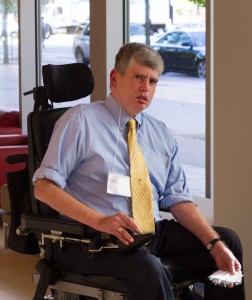
Daniel Perez, president and CEO of the FSH Society, represented the FSHD community at last week’s meeting of the Muscular Dystrophy Coordinating Committee (MDCC). The day-long meeting was held on March 17, 2015, at the National Institutes of Health (NIH) in Bethesda, Maryland.
Perez served on the MDCC from 2001 to 2010 and was re-appointed in 2014 with the unanimous endorsement of the FSHD Champions, an international alliance of FSHD advocacy and funding organization.
In his 2015 presentations to the MDCC, Perez highlighted the relatively small percentage of NIH grants awarded to FSHD projects–$7 million for FSHD out of the total $79 million awarded for all muscular dystrophies—and contrasted this to the impressive advances the field has achieved despite the lack of funding.
Much greater funding is required to address the most pressing challenges for FSHD research, including research on the following topics:
- Mechanisms of DUX4 toxicity
- More molecular, imaging and functional markers of disease progression
- Modifiers of disease: genetic, chemical, and lifestyle
- Preclinical models validated to represent aspects of FSHD pathophysiology
- Better animal models based on low expression of DUX4 as seen in patients
- Mechanisms of pathology in patients’ muscles
- Normal functions of DUX4 in tissues other than muscle
- Methods of administering anti-DUX4 agents to muscle
- Muscle regeneration capacity in FSHD muscles
- Large animal models (monkey, marmoset)
- Biomarkers that can indicate impact of therapeutic agents.
The Muscular Dystrophy Community Assistance, Research, and Education Amendments of 2001 (“MD-CARE Act”; P.L. 107-84) authorized the establishment of the MDCC to coordinate activities across NIH and with other Federal health programs and activities relevant to the various forms of muscular dystrophy. The MD-CARE Act directed the Committee to develop a plan for conducting and supporting research and education on muscular dystrophy through the national research institutes, and to submit this plan to Congress within the first year of the establishment of the MDCC.
The MDCC has conducted two stages of planning. The first stage led to the Muscular Dystrophy Research and Education Plan for NIH, which was submitted to Congress in August 2004. This formed the basis for a subsequent, more intensive planning process that produced the MDCC Action Plan for the Muscular Dystrophies (approved by the MDCC in December 2005). The Action Plan contains specific research objectives that are appropriate to the missions of all MDCC member agencies and organizations and thus serves as a central focus for coordination of research in muscular dystrophy.
View FSH Society’s MDCC presentation here.
Read the MDCC Meeting agenda here.


Leave a Reply